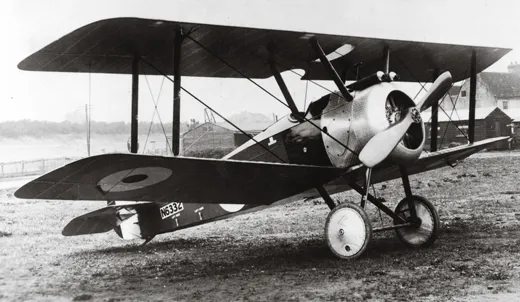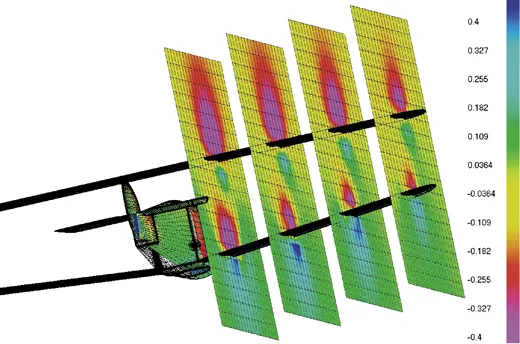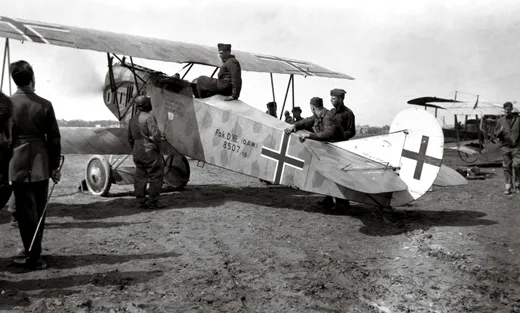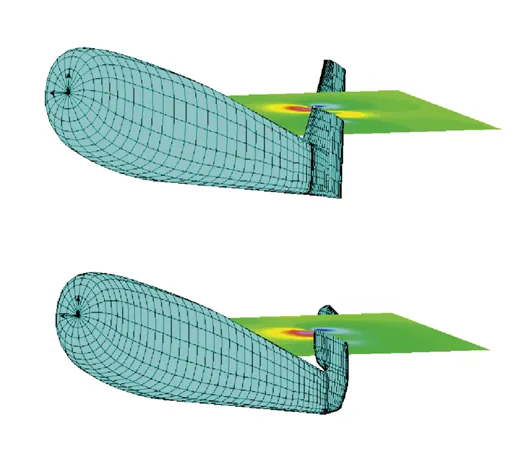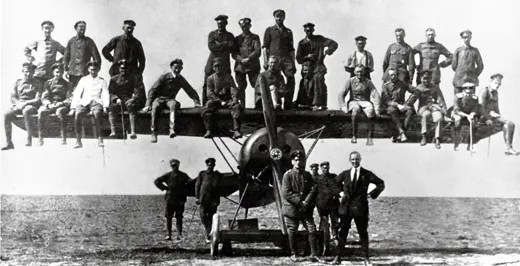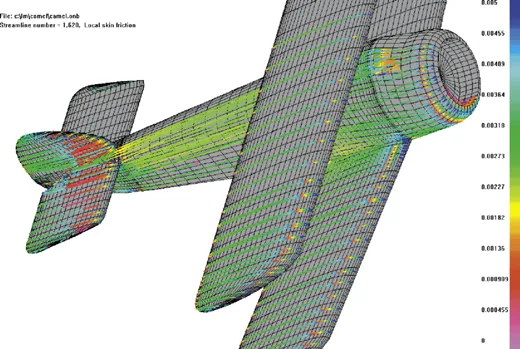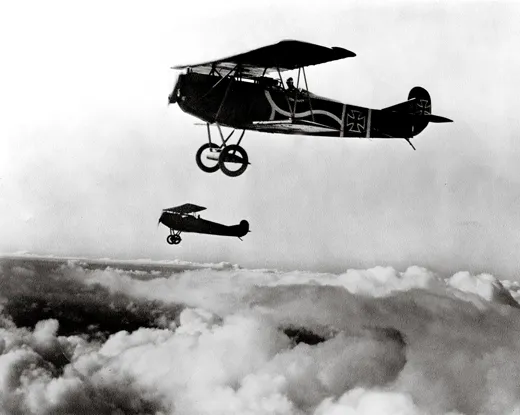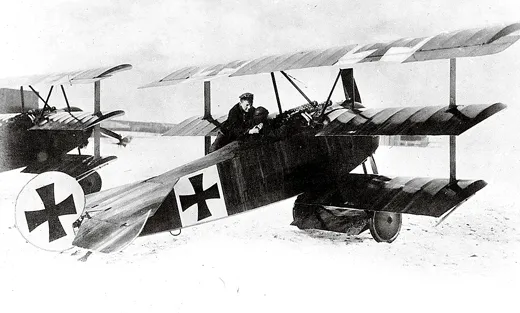What the Red Baron Never Knew
Computer analysis of World War I aircraft shows precisely why some were deadly and others, death traps.
/https://tf-cmsv2-smithsonianmag-media.s3.amazonaws.com/filer/wwi_631-feb08.jpg)
The “flying machine,” born only a decade before World War I, matured swiftly during its teenage years. By the end of the Great War, aviation had already adopted nearly every major feature that would characterize military and civil airplanes for the next three decades. Cecil Lewis, a British fighter pilot whose memoir Sagittarius Rising is a classic of the era, wrote, “Every new machine was an experiment, obsolete in the eyes of the designer before it was completed, so feverishly and rapidly did knowledge progress.” No other period in the history of aviation has seen such rapid evolution.
Most of the improvements emerged from trial and error. But what if designers during the first World War had had the tools for simulation and analysis that are available today? Many of the errors would have been avoided had the firms of Fokker, Sopwith, Nieuport, and the rest had a few desktop computers.
The first error, made with the first airplane, was soon corrected. When Wilbur Wright took the Flyer on a sales tour of Europe in 1908, the virtuosity and self-assurance of his daily demonstrations stirred up a fever of renewed aviation activity among the Europeans. But the very next year, Frenchman Louis Blériot flew across the English Channel in an airplane whose configuration looked nothing at all like the Wrights’. The world abandoned the Wrights’ design, an unstable canard biplane with pusher propellers and a central engine, promptly and without regret. Blériot’s design—single wing, direct-drive engine in front, tail in back—foretold all the best design conventions of the next half-century.
The airplane that crossed the channel was Blériot’s 11th creation, and none of the previous 10 had looked much like it or, for that matter, like one another. While the Wrights had painstakingly refined one idea through study and experiment, Blériot seems to have randomly caromed from one design to the next, inspired by a series of unconnected ideas, until he chanced upon one that worked. Now if he had had a PC… An elementary analysis calculating pressure distributions could perhaps have saved him the trouble of the first 10 discarded designs.
The first great fighter of World War I was essentially an improved copy of the Blériot XI—a sportsman’s airplane equipped with a gun. Called the Eindecker—the name means “monoplane”—it was designed by Anthony Fokker, a young Dutch engineer, pilot, and entrepreneur living in Germany. The Eindecker had an “interrupter” system, enabling its fixed, forward-pointing machine gun to fire through the propeller without chopping the blades off. (One of the mysteries of the history of technology is the inability of the British and French, who could build both engines and machine guns, to quickly contrive a satisfactory way to synchronize them.)
Mainly because of its superior armament, the Eindecker ruled the skies above the trenches during the first year of the air war. Newspapers on the Allied side spoke of the “Fokker Scourge.” That such a rudimentary and wayward machine could be the dominant fighter of its era only shows how primitive aviation still was at the start of the war.
By 1916, the Allies were producing fighters superior to the Eindecker, and the Fokker Scourge came to an end. The new formula, exemplified by the Allies’ various Sopwith and Nieuport models, was a wire-braced biplane with thin, essentially rectangular wings. The superior rigidity of the bridge-like wing structure enabled higher speeds and more agility, great advancements for dogfighting.
Then British builder Thomas Sopwith produced a triplane. To enhance pilot visibility, he narrowed the wing’s chord—the distance from leading to trailing edge—and, intending to replace wing area lost, added a third skinny wing. The Sopwith Triplane was a pleasant-flying, stable, and even warm and cozy airplane—not a small concern when pilots prowled at 18,000 feet. A brief but intense international flurry of triplane designing followed. However, the only model to reach the front was the Fokker Dr.I. The “Dr” stood for Dreidecker, or triplane.
Even though Baron Manfred von Richthofen scored a number of victories in this triplane, three wings was a bad idea (see “Fokker’s Inefficient Triplane,” p. 29). No doubt it seemed to many that more wing area would mean more lift, and therefore a better rate of climb, but the rate is determined by weight, power, and wingspan.
An aerodynamicist at the Massachusetts Institute of Technology, Jerome Hunsaker, saw the fallacy of the triplane arrangement and in 1916 published a critique of it. According to Leon Bennett, whose book Three Wings for the Red Baron explores the triplane phenomenon at length, a German translation of Hunsaker’s work “did much to dampen triplane hopes.” Nevertheless, hundreds of Fokker Triplanes were built, and a reputation of high performance—especially rapid climb—grew up around them. Von Richthofen, their staunchest advocate, claimed that his triplane could “climb like a monkey and maneuver like a devil.”
Modern tests and theory agree about the devil, but not about the monkey. If the Dr.I could, in fact, outclimb the Sopwith Camel biplane that it often fought, it was not because it had an extra wing but, Bennett suggests, because its propellers were pitched to deliver maximum power at climbing rather than cruising speed. Fokker Triplanes did in fact lack in top speed what they possessed in climb.
The Fokker Triplane actually did exhibit one extremely important design innovation, but it wasn’t the three-wing arrangement. It was the thick cantilever wings. Unlike most airplanes of its era, the Dr.I needed no struts or bracing wires to hold it together, as Fokker was fond of demonstrating by having a couple dozen of his shop workers pose on
a wing.
The idea of the thick cantilever wing seems to have originated not with Fokker, however, but with German Hugo Junkers, who came into his own as a manufacturer only after the war. Junkers’ all-metal monoplanes, a decade ahead of their time, had no external bracing at all.
It isn’t clear how Junkers came to the realization, around 1915, that a thick wing would not produce any more drag than a thin one. It was a counterintuitive notion; throughout the war, the British persisted in believing that thick-wing airplanes must be naturally inefficient.
Thick airfoils had a great advantage besides the structural one. Compared with thin wings, thick wings could produce more lift, by about 25 percent, because the gentle roundness of the leading edges helped air follow the curvature of the airfoil and not break away. The added lift did not affect climb rate, but it improved maneuverability, because the space within which an airplane can turn is determined by its maximum lift.
Triplanes could also fly in a very nose-high attitude, because the thick wing kept producing lift at angles at which the sharp-edged wings of Allied fighters had already given up. A U.S. pilot, James Hall, wrote of the Fokkers’ “trick of standing on their tails beneath one” with guns firing upward.
After von Richthofen’s death in 1918, another fighter, now considered the best of the war, quickly supplanted the Triplane: the Fokker D.VII. The D.VII had many assets, not least its Mercedes engine and uncluttered design. It was a sesquiplane, with a lower wing smaller than the upper.
Both sides conducted wind tunnel work during the war, but much of it was misdirected. A lot of effort was dedicated to determining the amount of camber, or curvature, a thin airfoil needed to produce the most lift. The correct answer was that camber did not matter as much as a thick, well-rounded leading edge; a highly cambered thin airfoil might produce more lift than a less cambered one, but it also produced more drag. Only the thick airfoil offered the best of both worlds.
Biplane fighters were still being built well into the 1930s, but the all-metal, low-wing monoplane, the type pioneered by Hugo Junkers, would dominate World War II. As a computer would show, a simple, uncluttered shape provides a total drag much less than that of a D.VII half the size. A suitable computer would have colored Fokker, who died in 1939, green with envy.
